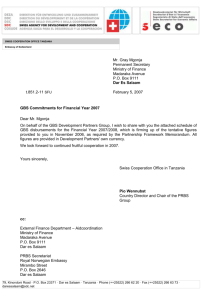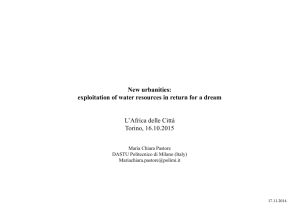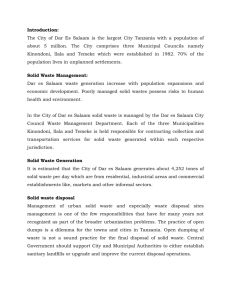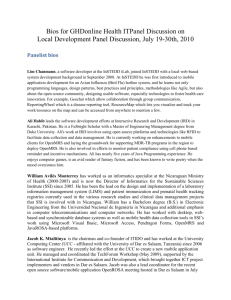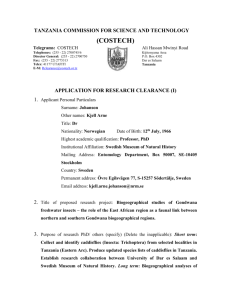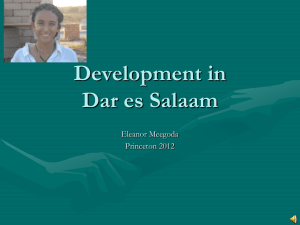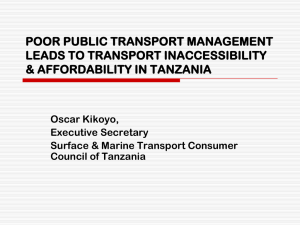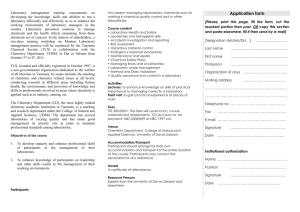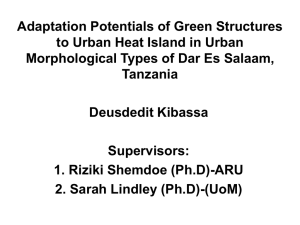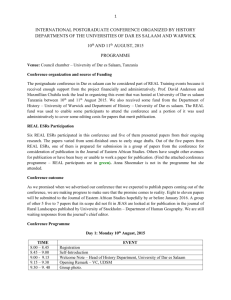Dar Es Salam City Council - South African Cities Network
advertisement
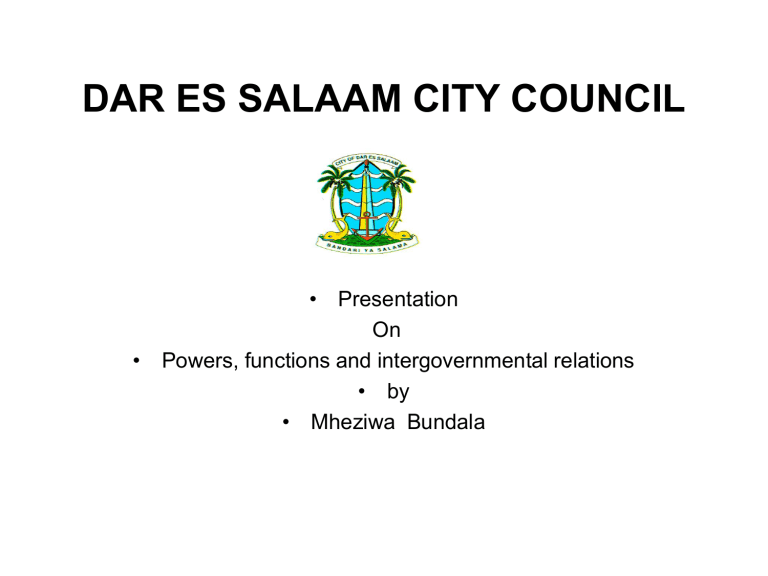
DAR ES SALAAM CITY COUNCIL • Presentation On • Powers, functions and intergovernmental relations • by • Mheziwa Bundala LOCATION OF Dar es Salaam AND BOUNDARIES OF THE THREE MUNICIPALITIES 2 The City • Dar es Salaam is Tanzania’s largest and most important industrial and commercial centre with an estimated population of about 3.1 million in 2010 which is approximately ten percent of the country’s total population. • It is almost eight times larger than Arusha which is the next largest city of the country. With a population growth of 4.3 percent per year, Dar es Salaam has become the third fastest growing city in Africa and among the tenth fastest growing cities of the world. The population of Dar es Salaam is expected to reach more than 5 million by 2020. Total area is about 1,400sq.kms (plus 272sq.km under Indian Ocean). Population density is 1,786 persons per sq.km. • Dar es Salaam accounts for 83 percent of the national government domestic revenues in Tanzania (70 percent of all taxes), collects 33 percent of all own-source revenues by Local Government Authorities in the country, and produces about 40 percent of the national GDP. • About half of the country’s manufacturing employment is located in the city. • LGA own source revenues are: Property tax, agricultural ceases, city service levies, land rent, licenses and fees, charges, and other miscellaneous revenues. Institutional & legal framework • Urban local government in Tanzania consists of five city councils (Dar es Salaam, Arusha, Tanga, Mbeya and Mwanza), six municipal councils and 11 town councils (these 22 urban `local government authorities’ plus their 92 rural counterparts account for the 114 Councils operating on mainland Tanzania). After an early period of local government during the colonial era, urban areas were from 1972 administered directly by central government. • Starting in the 1980s and especially from the mid-1990s, local government has been developed into its current form, which while apparently intending substantial political, financial and administrative decentralization, remains a strongly centralised system. Institutional & legal framework The legislative framework for local government is provided particularly by • Constitution of the United Republic of Tanzania, 1977 • Local Government (Urban Authorities) Act No 8 of 1982 • Local Government Finance Act, 1982 • Urban Authorities (Rating ) Act, 1983 • Regional Administration Act, 1997 • The Local Authorities Provident Fund Act (Act No. 6 of 2000) • This legislation is administered by the minister of state in the Prime Minister’s Office - Regional Administration and Local Government (PMO-RALG). The Office is responsible for 'ensuring the proper management of the finance of the local government authorities', and has a well-established system of budget guidelines, capacity building, technical support, and online reporting technologies for local governments The functions of local government • The functions of local government are broadly defined and include facilitating the maintenance of peace, order and good governance; regulating and improving agriculture, trade, commerce and industry; and enhancing health and education, and social, cultural and recreational life; • Local governments spend about one fifth of all public expenditure in Tanzania. About three quarters of local government expenditure is for `concurrent’ responsibilities, i.e. provided by the local government essentially on an agency basis with central government funding and regulation (examples include primary education, local health services, local road maintenance, and water supply, all of which are grant-funded). • Exclusive functions such as refuse collection and local government administration account for the remaining quarter of overall local government spending (Dar es Salaam City Council 2010a). • Dar es Salaam City Council (DCC) performs a coordinating role and attends to issues that cut across all the three municipalities. Functions of Dar Es Salaam City Council • The Dar Es Salaam City Council (DCC) performs a coordinating role and attends to issues that cut across all the three municipalities. The functions of the DCC are: • To coordinate the powers and functions of the three Municipal authorities regarding infrastructure. • To prepare a coherent city wide framework for the purpose of enhancing sustainable development. • To promote cooperation between the City Council and the three municipal or local authorities. • To deal with all matters where there is inter-dependency among the City’s local authorities. • To support and facilitate the overall functioning and performance of the local authorities. • To maintain peace, provide security and emergency, fire and rescue services, ambulance and police. • To promote major functions relating to protocol and ceremonies. Structure of local government authorities in Dar Es Salaam Organisational structure • City Councils are composed not only of members elected from each ward within the city but also the members • of the Parliament representing constituencies within the area of the city council; and also not more than three • members appointed from the residents of the city. The three Municipal Councils have 108 Councillors in all, 73 of which are elected. The Dar es Salaam City Council has 22 Councillors, all of whom come from the three Municipal Councils • City Councils are required to establish committees for finance and administration; economic affairs, health and education; urban planning and environment; and other committees as may be determined by the Minister. Organisational structure……. • City officials (department heads and key professionals) are appointed by central government, and the head of the city administration is appointed by the President . • All city employees can be transferred at any time by central government. A further important point is that key city officials, such as the Authorized Land Officers, are appointed by central government and report to central government on key aspects of their mandate. • The Public Service Act no 8 of 2007 requires that appointments for municipal posts take place through a central government Recruitment Secretariat, a system which started operating during 2010. Administration and Management of Dar es Salaam • In the year 2000, elected local government returned to Dar es Salaam, which is an administrative Region composed of a coordinating Dar es Salaam City Council (DCC) and three municipalities, namely: Kinondoni (KMC) to the north, Ilala (IMC) in the center of the region, and Temeke (TMC) to the south. • Dar es Salaam City Council (DCC) performs a coordinating role and attends to issues that cut across all the three municipalities. • The regional tier is a de-concentrated arm of the national government and is led by the Regional Commissioner. • The three Municipal Councils are responsible for the provision of basic social services that at present include: waste management and cleanliness; district roads; primary education and part of secondary education - especially where the community is involved; primary health care; monitoring trade and economic development activities (especially informal sector development and management, cooperatives, agriculture and livestock development, forestry, and fisheries); recreational parks; and urban planning. Municipal Characteristics • Ilala has the highest concentration of commercial activities since the area covers the core city and central business district and is commonly referred to as “downtown Dar es Salaam.” Many of Tanzania’s banks, commercial and administrative offices are located here. • Kinondoni has the largest population among the three municipalities and this is where the majority of Dar es Salaam’s higher and middle income population resides. This is reflected in higher traffic volumes, higher amount of solid waste generated and intensive socioeconomic activities. Kinondoni also collects more revenues than the other DLAs. • Temeke includes the city harbor and the largest portion of open undeveloped land among the three municipalities with a very high potential for future development. While this municipality is adjacent to the other two, it is separated by the harbor inlet without a connecting bridge to the central business district. With connections having to use a ferry, this municipality has a remarkably low density of physical development and population. Challenges Facing the City • The City of Dar es Salaam faces a number of challenges for the provision of public services, including: • Most of the city lacks basic services: More than 70 percent of the city’s population lives in unplanned and un-serviced settlements which lack access roads, pathways and street lights, have no drainage, and no solid waste collection systems. Such settlements occupy about 35 percent of the total developed land area of the city and are continuing to grow. • Traffic congestion has increased dramatically: severe congestion is no longer confined to peak hours (7:00-9:00 am and 16:30-19:30) and is now a day long experience on most arterial roads. • Lack of connecting roads: city road density is barely 0.84km/sq.km (which should be around 5km/sq.km.). A lack of roads and connections between existing roads coupled with an ever increasing number of vehicles adds to the deteriorating traffic congestion problems. Challenges Facing the City • Flooding is common: insufficient surface water drainage systems, lack of maintenance coupled with unplanned and ad hoc construction activities result in severe flooding which increases public health risks and poses a recurring danger to the existing already limited road and other network systems like underground communications cables and water supply pipes. • Solid waste management is an increasing problem: increased volumes of solid waste generation and a lack of effective collection systems are creating environmental health stresses. Only about 40 percent of the solid waste generated is actually collected and transported to dump sites. • Rapid and continued growth of the informal sector : increasing informality forces an increasing number of youth to trade and sell along already highly congested roads and unsafe areas. The rapid population growth in the city causes mushrooming of informal activities, conducted in unauthorized areas, leading to environmental degradation and congestion Challenges Facing the City • Insecurity and crime rates have been rising: 43 percent of the households polled in one survey reported that they had been burgled over a five-year period and 32 percent reported simple thefts. • City management systems are unable to cope with city growth: Human, institutional and financial capacity constraints for urban management urban development (financial resources, skilled manpower, and modern equipment needed). • . Major Ongoing Initiatives • Community Infrastructure Upgrading Program (CIUP): CIUP is being implemented in all three municipalities, coordinated by DCC with around US$ 30 million funding through the World Bank under an International Development Association (IDA) credit. CIUP is being implemented in two phases and is one sub-component of a larger Local Government Support Project (LGSP). • The first phase of the CIUP was completed in May 2010 providing to the community access roads and footpaths with road side drainage, select trunk road connections, street lights and solid waste collection points in 5 sub-wards of the three municipalities. • Under the second phase of CIUP a further five sub-wards will receive similar inputs. Once both phases are completed in 2012, CIUP will have upgraded around 20 percent of the city’s total unplanned settlements. Major Ongoing Initiatives • • • • • • • The Dar es Salaam City Council (DCC) and the three municipalities of Ilala, Kinondoni, and Temeke propose an overall infrastructure development programme as a framework for engaging development partners in the city’s continued development. This programme focuses on five main areas: Roads (which are under the DLA’s responsibilities); Surface water drainage systems); Solid waste management (collection, transportation and disposal) system; Community infrastructure upgrading; and Improved urban and financial management. A total of US$ 375 million is estimated to be required for this programme Major Ongoing Initiatives • In addition, initiatives are needed for continued local economic development (LED) to support and facilitate the rapidly growing urban informal economy • With thanks = Asanteni Sana
